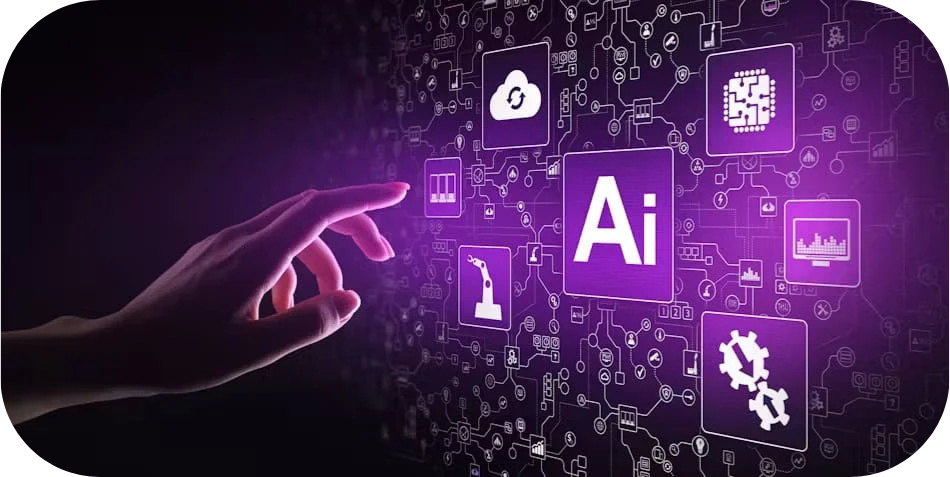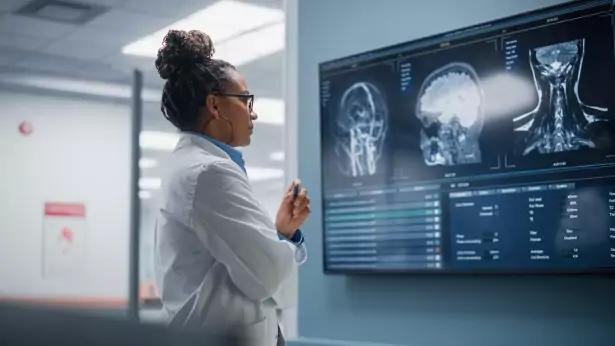Artificial Intelligence (AI) in healthcare is no longer a topic of tomorrow — it’s a present-day reality. Ambient note taking, medical imaging diagnosis, and virtual health assistants are becoming increasingly involved in care delivery.
The global AI in healthcare market is projected to grow from $14.92 billion in 2024 to $110.61 billion by 2030, at a robust 38.6% CAGR, according to the MarketsandMarkets 2025 report.
What may be surprising, however, is that the greatest impact isn’t coming from clinical decision-making or diagnosis. Instead, the biggest gains are emerging from AI applications in healthcare operations that are cutting waste, boosting efficiency, and enhancing the experiences of both patients and staff.
The Rise of AI in Healthcare Operations
Today’s modern hospitals are facing operational challenges such as bed shortages, staff burnout, inefficient equipment allocation, and fragmented communication between departments, prompting leadership to ask: “How can AI be used in healthcare operations to improve efficiency and patient experience?”
From AI-powered real-time location systems (RTLS) to predictive analytics platforms and AI agents, hospitals can now anticipate bottlenecks, enhance staff workflows, and optimize patient journeys. AI provides the power to finally analyze the wealth of real-time data and dynamically allocate resources efficiently, allowing hospitals to maintain high-quality care while reducing costs.
But even with narrow focus on healthcare operations, there are dozens of use cases to explore. Where are the measurable impacts? What is the investment? What are best practices for evaluating and implementing AI in healthcare operations? What terms do I need to know?
In this guide, we’ll answer those questions and further explore topics around AI in hospital operations, including:
- The key uses of AI technology transforming hospital operations
- Use cases such as asset tracking, patient journey optimization, staff safety, and predictive analytics
- Best practices for successful AI adoption in U.S. hospitals

AI Applications in Healthcare – Key Technologies Driving Change
The promise of AI in healthcare operations becomes most visible when applied to specific, high-impact use cases. For today’s hospitals functioning with razor thin margins, any technological investment needs to drive very real and practical improvements in financial sustainability, staff wellness and efficiency, and patient outcomes; ideally all three areas.
Every operational inefficiency in a hospital carries a financial cost. From misplaced assets to delayed discharges, the cumulative impact is enormous. AI reduces these inefficiencies by streamlining processes, lowering avoidable expenditures, and improving throughput.
Let’s take a look at some of these impactful and measurable use cases.
AI-Powered RTLS Asset Tracking: Optimizing Utilization and Right-Sizing Inventory
Traditional real-time location systems (RTLS) were designed to answer a simple question: Where is my equipment? But when paired with AI, the system evolves into a powerful optimization tool. Instead of simply locating devices or patients, AI-driven RTLS in hospitals uncovers hidden workflow patterns and inefficiencies. At Kontakt.io, we call this Intelligent Orchestration.
With AI-powered RTLS asset tracking systems, hospitals can:
- Improve patient flow by removing operational bottlenecks, unlocking additional revenue – $30M per 1K beds, annually – with shorter length of stay and higher patient throughput.
- Boost asset utilization by 30% with automated PAR-level inventory management that can then defer future CAPEX purchases
- Enhance patient experience by anticipating needs and automating routine tasks, with real-time, end-to-end visibility into each patient’s journey
Healthcare systems often face hidden costs from underutilized equipment and overstocked inventory. This shift from data collection to AI-driven, actionable insights in healthcare operations marks the true arrival of next-generation RTLS.
AI Agents: Deputy House Manager
Designed to support charge nurses and house managers, Kontakt.io’s AI Deputy House Manager acts as an operational co-pilot so that house managers can work to the top of their scope and to maximize their effectiveness in such an important role for the hospital. The Deputy House Manager frees caregivers from logistical distractions, allowing them to focus on what matters most — delivering high-quality patient care — by eliminating or reducing tedious, manual work, including:
- Providing support through chat and call modalities throughout a House Manager’s shift
- Producing summarized analysis of current state, surfacing impending issues, and facilitating communication across departments
- Notifies house managers about patient flow issues, equipment shortages, or staffing gaps before they escalate, which allows for timely intervention
Staff Safety: Enhanced with AI Analysis
Staff safety is one of the most urgent concerns in U.S. hospitals. Burnout and workplace violence are growing threats that undermine both morale and patient care. Everyone deserves a safe work environment. With AI-driven analysis applied to Kontakt.io’s staff safety solution, protecting staff members goes beyond duress response to include predicting and even preventing incidents.
- Identify trends and high-risk environments with actionable insights that help leaders strengthen safety.
- Predict when and where duress is most likely by analyzing historical patterns and real-time data.
- Take proactive measures to reduce risk, preventing harassment and violence before they escalate.
Learning and teaching key de-escalation techniques while adopting technology that scales staff safety with rapid response and predictive analysis, hospitals can reduce the likelihood and severity of violent incidents against frontline staff members.
Improving the Patient Journey with RTLS and AI
AI doesn’t just optimize operations behind the scenes, it can also elevate the patient experience. By integrating with EHR systems and virtual assistants, AI enables next level efficiency at every step of the patient journey:
- Seamlessly monitor patient movements throughout their stay, creating an accurate picture of their journey.
- Identify and optimize interactions between patients, clinicians, and hospital resources such as beds, IV pumps, and more
- More efficient discharge planning and bed turnover, ensuring faster access for incoming patients.
The result is a win-win: patients benefit from a smoother care journey, while hospitals gain greater efficiency, improved throughput, and optimized resource utilization.

Best Practices for Implementing AI Applications in Healthcare
Implementing AI in healthcare is not simply an IT project — it’s an organizational transformation. To succeed, healthcare leaders must balance operational priorities, regulatory considerations, staff adoption, and long-term scalability. Below are proven best practices that ensure AI delivers measurable results while aligning with your hospital’s longterm financial and technological strategies.
Define Strategic Goals and Measurable Outcomes
Leaders should first identify specific pain points or business challenges — for example, prolonged bed turnover times, equipment shortages, or high rates of staff duress incidents — and focus on solutions that can quickly and easily help solve those challenges.
- Tie each initiative to business outcomes such as reduced capital expenditures, higher staff retention, or improved patient throughput.
- Translate outcomes into KPIs such as average wait time, asset utilization rates, or staff incident reports.
This creates a clear baseline to measure progress and demonstrate ROI to stakeholders. AI initiatives often fail when organizations pursue “innovation for innovation’s sake.”
Select Low-Barrier, High-Impact Use Cases
Clinical AI applications like diagnostics or treatment planning carry high regulatory and reputational risk. Operational AI, by contrast, provides fast, measurable wins with lower barriers.
- Examples: AI-powered RTLS asset tracking, patient flow, or staff safety
- Value: These solutions reduce inefficiencies, prevent loss, and enhance safety — delivering measurable improvements in months, not years.
By proving value in operations, hospitals build the foundation for scaling AI into more complex areas later.
Build Toward Data Interoperability
AI is only as strong as the data it learns from. And AI can deliver the most value when working with a comprehensive data perspective. Unfortunately, healthcare data is fractured and siloed across EHRs, RTLS solutions, and often hundreds of tech vendors.
- Audit existing data sources for accuracy, completeness, and interoperability.
- Standardize data collection processes (e.g., IoT sensors, staff badges, patient tracking devices) to ensure consistency.
- Establish data governance frameworks for ownership, quality control, and compliance with HIPAA and GDPR.
This proactive work minimizes errors and builds confidence in AI-generated insights.
Integrate Seamlessly with Existing Workflows
Even the most valued AI solution will fail if it disrupts staff routines. Hospitals need to focus on embedding AI into tools clinicians and managers already use.
- For example, integrating RTLS insights directly into nurse dashboards and EHR systems ensures adoption without adding extra steps.
- Automation should enhance — not replace — clinical staff, providing actionable recommendations and automating tedious manual work to free clinicians to work at the top of their license.
Build Transparency and Trust with Staff
AI adoption is as much a cultural change as a technological one. Frontline workers need to understand how AI supports them and makes their jobs easier (and not replacing them).
- Involve clinicians, nurses, and administrators early in implementation discussions.
- Provide training and visibility into how AI makes decisions (e.g., dynamic resource allocation).
- Frame AI as a “co-pilot” who automates routine tasks so staff can focus on patient care.
The Future of AI in Healthcare Operations
From real-time location systems (RTLS) to predictive analytics and AI agents, hospitals now have the tools to eliminate waste, improve staff well-being, and optimize patient flow. Yet, successful adoption depends on clear strategy, data interpolation, and collaboration between technology partners, hospital leadership, and frontline staff.
For healthcare leaders, the opportunity is clear: AI can help transform operations from reactive problem-solving to proactive, data-driven resource management — bolstering financial stability, improving staff wellbeing, and optimizing patient outcomes.
Discover how Kontakt.io’s AI-powered RTLS, staff safety solutions, and AI Agent: Deputy House Manager are helping leading healthcare systems cut inefficiencies, enhance safety, and improve care delivery.





